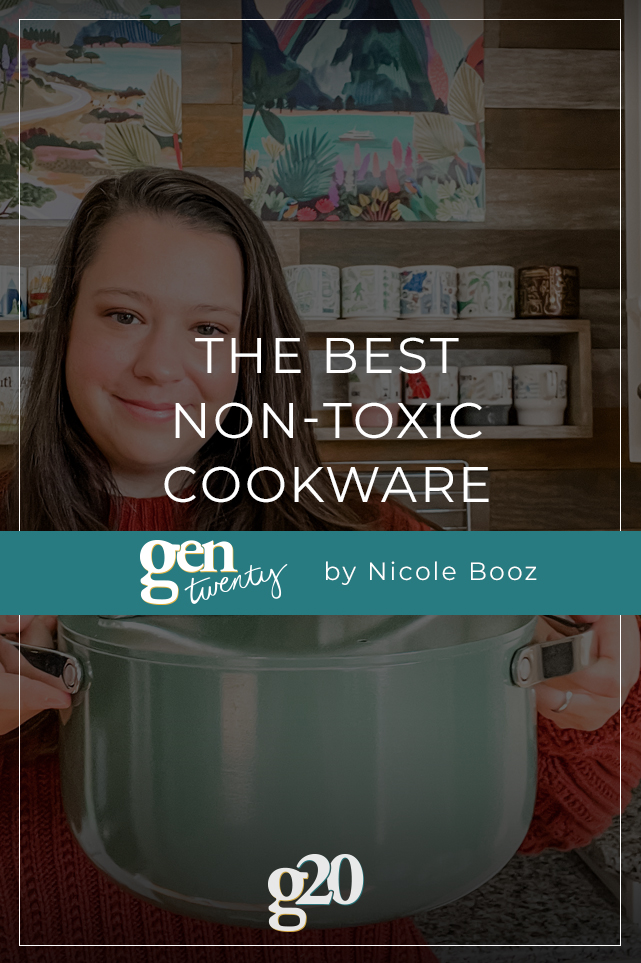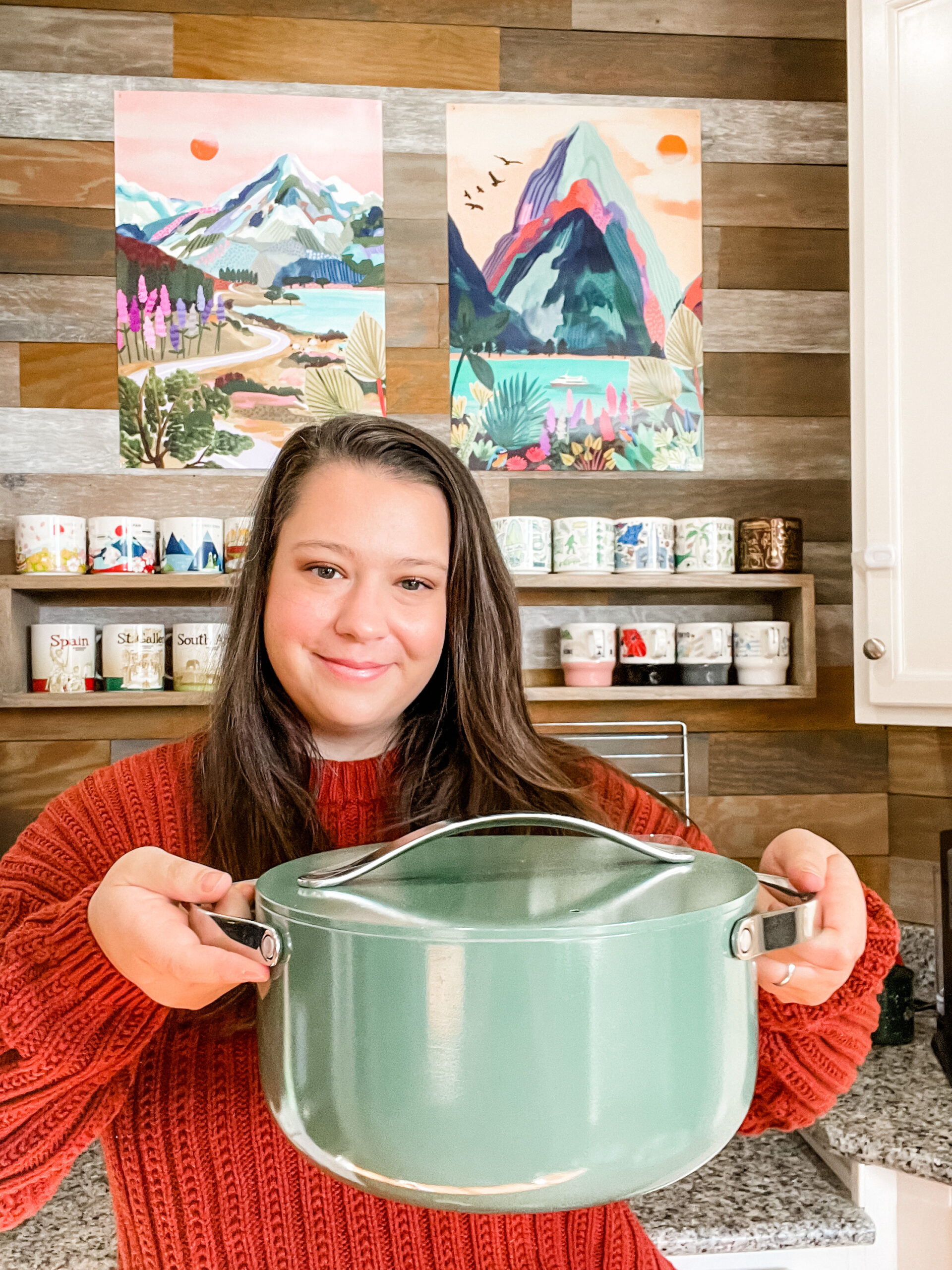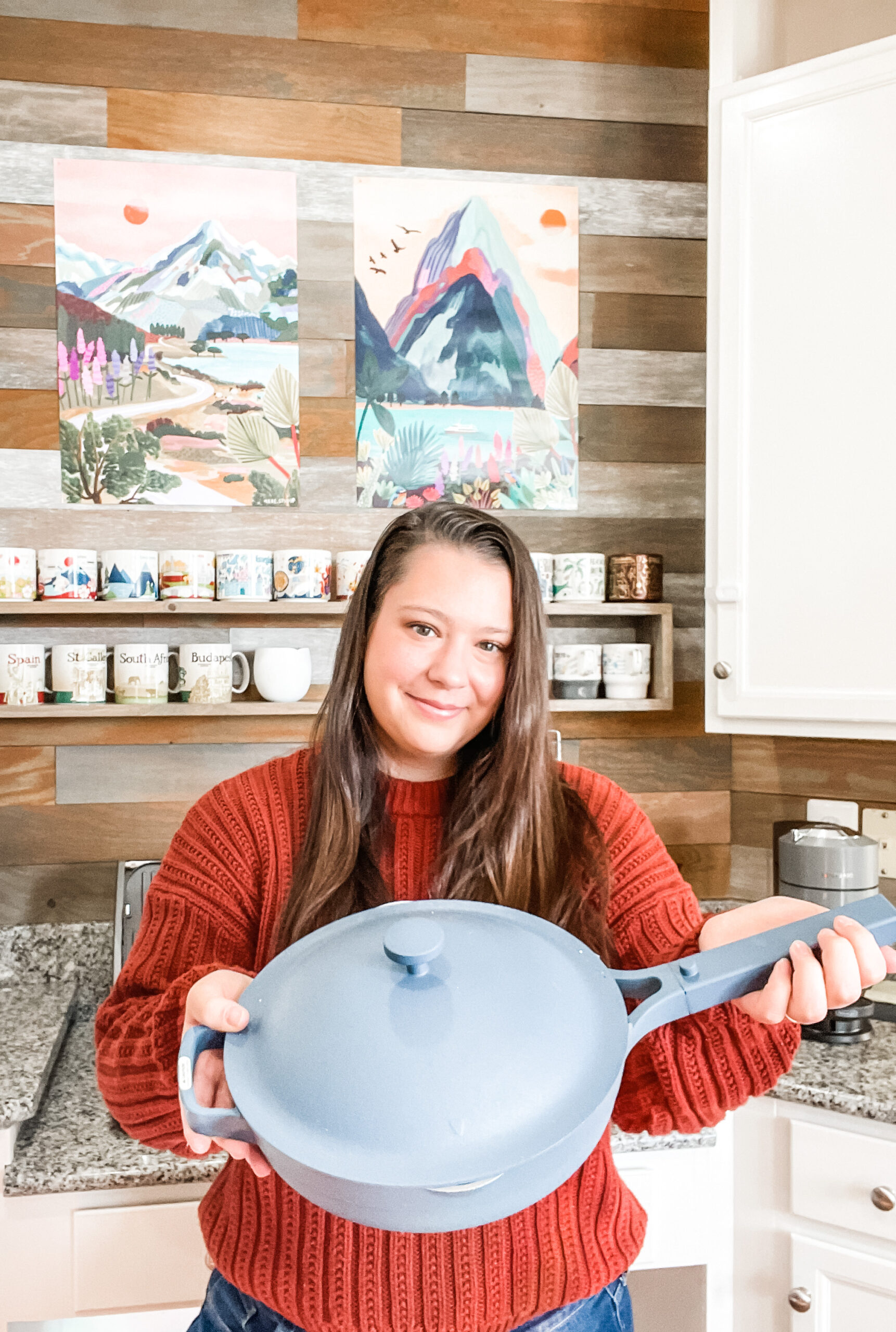Chances are the cookware you’re using in your kitchen is toxic. Many readily available cookware options release toxic fumes into the air and leach chemicals into your food. It’s not really something we want to hear, but it is very important that you do something about it!
This post contains affiliate links.
What To Avoid In Your Cookware
Many cookware options on the market advertise themselves as “free from” a variety of different chemicals and compounds, but what are those exactly? Here’s a quick little breakdown:
- PFAS: A group of thousands of lab-created chemicals that include things like PFOA, PFOS, GenX, and other compounds that have been found to have toxic effects on humans.
- PTFE (AKA Teflon): PTFE or polytetrafluoroethylene has been used in nonstick pots and pans, however, the research has shown that chemicals can leach from the pans during use and are toxic for both our bodies and the environment. Fumes from these pans have cause polymer fume fever and have killed pet birds. It’s fairly common knowledge to not use metal utensils on teflon-style pans because they can leach particles into your food. Teflon cookware has found to be hazardous to your health, however, many brands still produce pans with it.
- PFOA: Perfluorooctanoic acid (PFOA) is man-made and were used in products that resist heat, oil, stains, grease, and water as well as stain-resistant carpets, fabrics, and PTFE nonstick cookware up until 2015. While they are no longer produced, many of these products are still circulating. PFOA has been linked to cancers, thyroid disease, and developmental impacts on a fetus and breastfed infants.
- Gen X: Gen X was introduced as a “safer” non-stick option, however, research has shown that it is has show adverse effects on the liver and blood and cancer of the liver, pancreas, and testicles in animal studies. It’s it is best to avoid it.
- Aluminum: The toxicity of aluminum cookware has been discussed many times. Aluminum is widely used in the manufacture of cookware because it is cheap, lightweight, heats evenly and it’s also non-toxic. But at what point does it become unsafe? Aluminum contamination in brain tissue has been implicated in Alzheimer’s disease so aluminum cookware is not necessarily something you would want to use every day. Aluminum can safely be in the body of a pan as long as the aluminum surface is not exposed directly to food and/or is stainless steel coated.
- Cadmium: Excessive amounts of cadmium and its compounds are highly poisonous and have been shown to cause cancer in humans. The body’s cardiovascular, renal, gastrointestinal, neurological, reproductive, and respiratory systems are all affected by exposure to this metal. There is no safe amount of exposure to cadmium.
- Lead: Exposure to lead causes anemia, weakness, kidney and brain damage in some people. Lead can cross the placenta, which means that pregnant women who are exposed to lead also expose their unborn child. Lead can harm a fetus’s nervous system during development. There is no safe amount of exposure to lead.
As you can see, there are many unsafe compounds that end up in our cookware due to poor regulation and testing.
So, what are the safest options for cookware?
Despite there being many unsafe cookware options available, there are a decent number of safe types of non-toxic cookware to choose from.
The EWG (Environmental Working Group) suggests using cast iron, stainless steel, and oven-safe glass as the safer options, however, there are many great options available now that are free from toxic chemicals and compounds. These include:
- Stainless steel: Can last a very long time and stand up to a range of uses while being a great non-toxic option.
- Cast iron: A very popular choice that last longer than almost any other type of pan when properly cared for.
- Ceramic-coated Nonstick Pans: Popular for it’s ease of use, it’s hard to find truly non-toxic cookware but we do have a top pick.
- Carbon Steel: A newer option that has similar properties to a cast iron pan but is more lightweight.
- 100% Ceramic: Very versatile choice that is made with a singular material. It’s best for certain types of cooking so not the most practical all around choice.
Pros and Cons of The Safe Cookware Options
Stainless Steel
- Pro: Stainless steel pans are scratch-resistant, non-toxic, long-lasting, and very durable.
- Con: The major disadvantage of stainless steel is that it is not non-stick, so additional oil must be used to prevent food from sticking in the pan.
Tip: When purchasing stainless steel, be sure you’re getting food-grade stainless steel rather than industrial grade. Industrial grade stainless steel contains more nickel and/or chromium, which have the potential to leach into food, it’s not ideal for preparing or storing meals.
Cast Iron
- Pro: Cast iron is extremely durable and can be non-stick when seasoned properly.
- Con: It is heavy and can take practice to learn how to clean properly. However, many people swear by cast iron pans.
- Con: Cast iron can leach iron into your food which is good and/or not problem if you are deficient in iron but if you have too much iron in your body, it’s best to not use cast iron pans.
Tip: Do not cook acidic foods (like tomato sauce) in a cast iron skillet or pan.
Ceramic
- Pro: Ceramic and ceramic coated pans and non-stick and very easy to clean which makes both cooking and cleaning a breeze.
- Pro: Due to the non-stick coating, you need to use less oil and fats to cook with.
- Con: You cannot use metal utensils with ceramic pans as it will breakdown the non-stick properties.
- Con: Ceramic is best used over low to medium heat as high temperatures will wear down the ceramic over time.
- Con: Non-stick pans are often made with an aluminum core.
The Best Non-Toxic Cookware
If you’re looking to purchase the best non-toxic cookware, the good news is that there are many options available. These high quality options are free of toxic chemicals. Let’s take a look.
1. Caraway Cookware (Non-Stick Ceramic)
I’ve been using Caraway’s full set of cookware for several months now and am so pleased with the performance. Their non-stick coating is mineral based and is not made with PFOA, PTFE, lead, cadmium, other PFAs, and heavy metals. Their cookware materials for a nonstick surface provide one of the safest cookware options on the market.
The set also comes with a unique storage system that is very convenient to use and stay organized with. Each pan has it’s own magnetic holder and you can organize them in the way that fits best for you in your space.
Buy Caraway Cookware: Full Set, Fry Pan, Sauté Pan, Sauce Pan, Dutch Oven
2. The Our Place Always Pan and Pot (Non-Stick Ceramic)
This is a popular option if you are looking for a more all-in-one kind of pan. It’s made from ceramic and made without PFOAS and PTFES. Both the pan and pot are multi-functional.
The Always Pan:
This one pan works as fry pan, sauté pan, steamer, skillet, saucier, saucepan, non-stick pan, spatula, and spoon rest, which is an attractive option if you’re low on space or trying to buy less. It has a non-toxic, non-stick ceramic coating that is made without PFOAs, PTFEs, other PFAs, lead, cadmium, toxic metals, and nanoparticles. It also comes in really beautiful colors!
The Perfect Pot:
The pot has a heavy gauge cast aluminum body and non-stick cooking surface that works best over low to medium heat. It is oven safe up to 425 degrees. It works on induction cooktops and weighs just 4.5lbs with the lid on. It’s made without potentially toxic materials like PFOAs, PTFEs, other PFAs, lead, cadmium, toxic metals, and nanoparticles.
If you’re choosing between Caraway and Our Place:
If you have the budget for Caraway, that is what I would pick personally. I own both and I do not think that the Our Place Pan has the longevity of Caraway.
Buy Our Place: The Always Pan, The Perfect Pot
3. 360 Cookware (Stainless Steel)
This is an Environmental Protection Agency (EPA) recognized brand that does not use harsh chemicals in their cookware. It also comes with a lifetime warranty so you can rest assured that your cooking and your purchase is protected! There is a secret to cooking with stainless steel that once you know it, it becomes so much easier to cook with and to clean. No more cooking eggs that get stuck to the pan! They have great stainless steel cookware sets that will go the distance.
4. Great Jones Goods (Stainless Steel)
Great Jones Goods offers a huge range of fully clad stainless steel cookware for every culinary skill level. It’s safe up to 500 degrees Fahrenheit and dishwasher friendly, so it’s useful in a variety of ways.
Nonstick surface features from Jones Goods include a German ceramic coating that is healthier for consumers and better for the environment since it’s free of Teflon, PTFE, and PFOA.
5. Field Company (Cast Iron)
The Field Company is a non-toxic cookware company founded by two brothers, Stephen and Chris Muscarella, who wanted to bring back the smooth, light cast iron skillets of the past.
This American-made company produces their pans to be lighter and smoother without chemical processing. They are pre-seasoned with grapeseed oil and are made with a heat ring for even cooking on every surface.
6. Finex (Cast Iron)
Finex is a Portland, Oregon, cast iron company that specializes in producing non-toxic cookware that will endure the test of time. Handcrafted Finex cast iron skillets are polished, tumbled, pre-seasoned, and completed by hand.
A unique feature of Finex is that the handles are made of stainless steel and have ergonomic grips that keep them cooler for longer.
7. Xtrema (100% Ceramic)
The non-toxic cookware from Xtrema is constructed of 100% pure ceramic. Their cookware has been approved by the FDA and meets California Prop 65 standards, demonstrating that it is free of more than 800 chemicals that might cause cancer, birth defects, or other reproductive harm.
It’s the only genuinely ceramic cookware available that can be used on the stovetop, in the oven, and in the microwave, making it ideal for one-pot meals as well as braising, simmering, and baking which makes it extremely versatile in the kitchen. Xtrema has even heat distribution making it a versatile option for the home cook.

The Bottom Line About Non-Toxic Cookware
The only way to truly know if a product is non-toxic is to look at the raw material source and make sure there are no harmful chemicals. Most manufacturers do not explicitly state which chemicals are in their product and it’s best to assume that they’re using the same toxic materials as traditional cookware.
Using non-toxic cookware is important because you are ingesting whatever chemicals are in your cookware every time you eat. These health concerns from standard cookware make it worth the effort to find cookware that does not leach chemicals and is made with care.
Non-Toxic Living Guides:
- Non-Toxic Outdoor Dinnerware For Healthy Eating
- Best Non-Toxic Tea Kettle for Your Kitchen
- The Best Non-Toxic Dinnerware for Healthy Eating
- The Best Non-Toxic Baking Sheets
- The Best Non-Toxic Sofas For Your Home
- 19 Affordable Non-Toxic Makeup Brands You Have To Try
- The Best Non-Toxic Cookware For Healthy Eating
- Caraway Bakeware Review – Is It Worth It?
- Best Non-Toxic Facial Moisturizer For All Skin Types
- The Best Non-Toxic Candles
- 15 Affordable Non-Toxic Skin Care Brands
- Best Organic Wine Club
- 25 Non Toxic Indoor Plants – Safe For Pets & Kids
- 18 Best Non Toxic Body Lotion Picks
- 8 Organic Cotton Padded Bra Options
- 20 Best Organic Under Eye Concealer Picks
- 8 Best Places to Buy Organic Food Online
- 10 Best Organic Tea Brands (Top 10)
- 12 Affordable Eco Friendly Swimwear Brands
- 11 Best Non-Toxic Coffee Maker Picks 2023
- 10 Best Organic Flavored Coffee Brands
- 15 Affordable Organic Clothing Brands
- 8 Best Organic Bamboo Sheets
- 12 Non-Toxic Food Storage Containers‘
- The 7 Best Non-Toxic Hair Dye Brands
- Brand Directory


